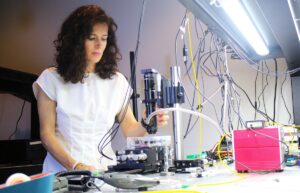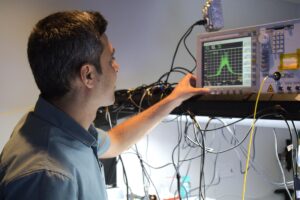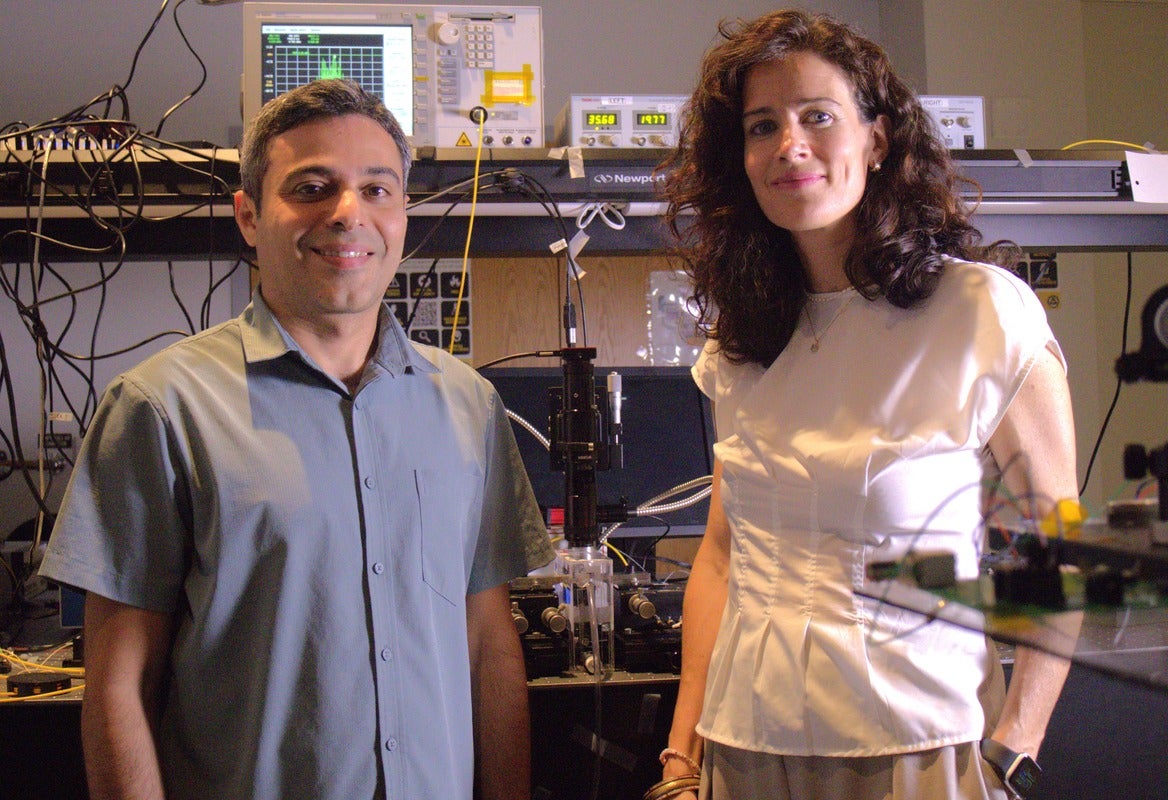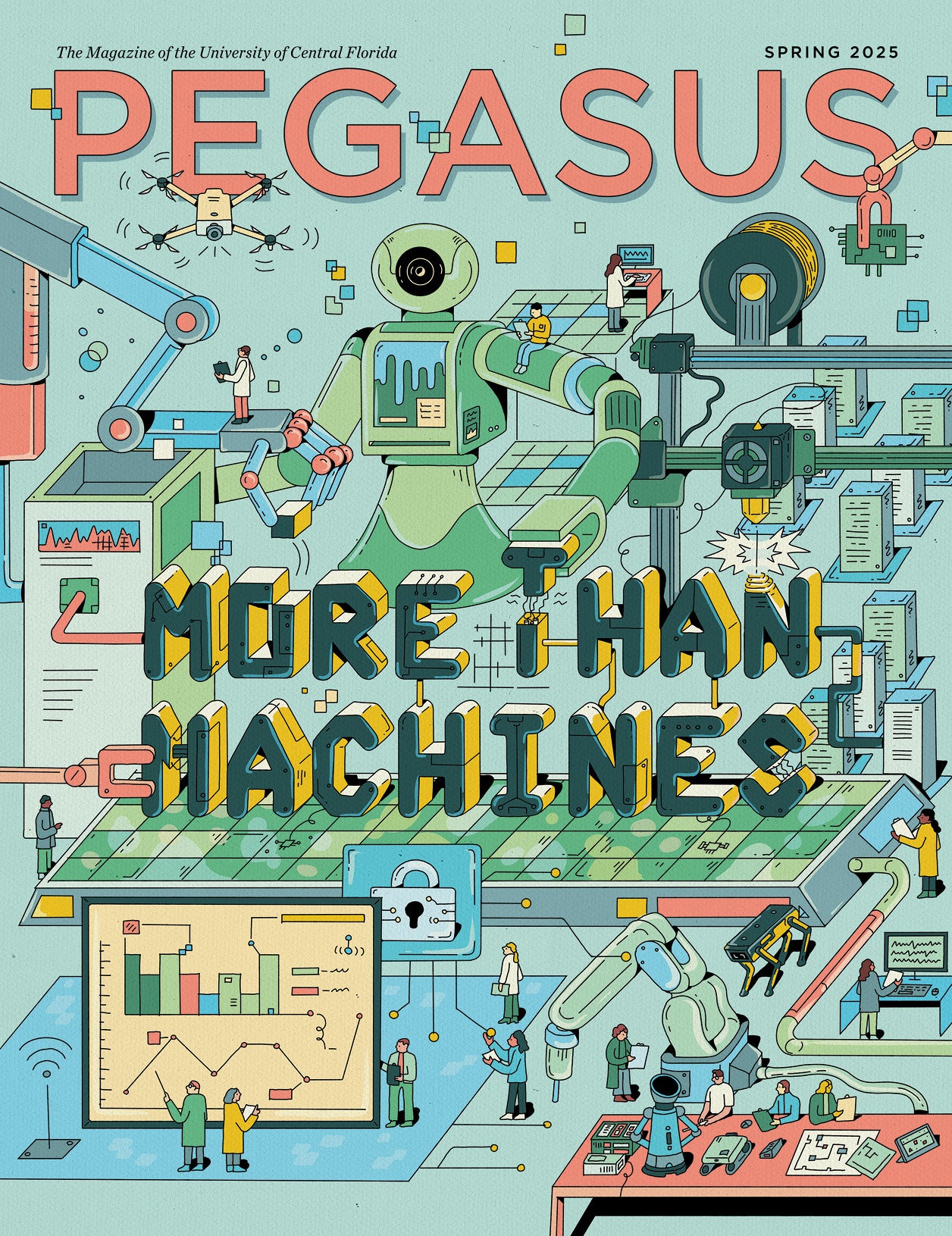The building blocks of the future can be hard to see — unless you know where to look.
While many researchers at SpaceU scour the stars in search of our universe’s secrets, others are focusing their attention on the opposite direction: the tiny, strange and exciting world of quantum mechanics. Understanding how things behave in that environment — especially light — could be the key to future technological breakthroughs.
Andrea Blanco-Redondo is the Florida Photonics Center of Excellence Endowed Professor of Optics and Photonics at CREOL, the College of Optics and Photonics. She heads the Quantum Silicon Photonics (QSP) research group, which aims to better understand the fundamental properties of light. Their research will be necessary to one day make our quantum technological aspirations a reality. Quantum computing, for example, leverages principles in which photons can be in multiple places and states simultaneously to achieve vastly enhanced processing power.
“Understanding these things better is going to lead to real advances in quantum computing, quantum sensing and quantum information science in general,” Blanco-Redondo says.
However, fully understanding the world of the small is no small task. Fraught with unpredictability and disorder, the tiniest imperfections and errors of nanofabrication can hinder the scalability of quantum systems to the levels researchers hope to achieve.
“Quantum states are very, very fragile, with respect to any kind of perturbation from the environment, so you need to somehow provide protections for the states,” study co-author and CREOL doctoral student Amin Hashemi Shahraki ’24MS says.
That’s where the QSP group comes in. Their recent work published in Nature Materials demonstrated the use of a platform to precisely control the dissipation, or loss, of quantum states of light, which in turn leads to robust topological properties.

“The reason this could have a technological impact is because we are always looking for ways to realize devices that are robust to imperfections that we cannot avoid,” Blanco-Redondo says.
The fundamental breakthrough is an important step toward further understanding and controlling these quantum states of light that will one day power devices of the future.
Tracking the Topology
The integrated electronic circuit is ubiquitous in modern society. Better known as a microchip, it’s no secret that this cornerstone of electronics is essential for computers, cell phones, cars and even appliances. Similarly, a photonic integrated circuit is also a small chip — but one that uses photons instead of electrons.
Blanco-Redondo says a key advantage is that these circuits confine light at the nanoscale, where it behaves differently than it does while traveling through free space or inside fiber optics. It also enables nonlinear interactions, which are produced when light interacts strongly with matter.
“Say two photons that come from an initial laser strongly interact with matter,” Blanco-Redondo says. “What happens is they basically disappear and they give rise to two other photons. These two photons are actually quantum correlated. So just by that nonlinear process, we can create photons that have what’s called entanglement, which is a very fundamental property of quantum particles.”
Apart from the promise of quantum computing, Blanco-Redondo says this research will also lead to advancements in the field of sensing.
“With classical sensors, there’s basically a noise level that you can never surpass,” she says. “When you start using certain quantum properties of light, like superposition, entanglement or squeezing, there are ways to surpass that classical limit and make sensors that are better than anything classical out there.”
The research publication, “Observation of Non-Hermitian Topology from Optical Loss Modulation,” explores how quantum properties can be used in integrated photonics systems. “Topology” in this case refers to the band structures that determine how photons propagate — similar to the electron band structures found in semiconductors. In a closed system — the most common type that has been studied — there is no hypothetical gain or loss of photons. Non-Hermitian systems, on the other hand, represent open systems where energy enters or leaves, like through gain, loss or decay.
“All these studies were basically dealing with systems, where they had this topology, and then you add loss, and then you see what happens,” Blanco-Redondo says. “What we have done is to observe that topology can appear just because of the presence of loss.”
Blanco-Redondo says introducing that loss in a way that’s controllable is not an easy process. Their solution was to use a photonic version of a field-programmable gate array (FPGA), which the group had previously demonstrated as a method to implement topological photonic models.
“But now what we have realized is that you can use it to control the loss very precisely, which has allowed us to demonstrate the appearance of topology solely from loss modulation,” Blanco-Redondo says.

When the team modulated the loss in specific ways, they noted the appearance of localized modes of light, which were robust to certain types of disorder. This realization is an important step toward dealing with the fragility of quantum states. In the application of quantum computing, for example, reducing these imperfections reduces the error rate toward a level necessary to achieve useful computations.
“If you can build electromagnetic modes or ways to guide light in a way that is robust to these kinds of imperfections, that could have a tremendous impact,” Blanco-Redondo says.
Another potential application: topological lasers — which have the potential to provide superior performance, efficiency and stability compared to traditional lasers.
The Future of Quantum Photonics
The research’s publication in Nature Materials means the work will reach beyond the optics and photonics field, granting it an audience to a broad scientific community of many disciplines for collaboration.
“Being featured in such a prestigious journal, known for its influence across disciplines, is really exciting,” Hashemi Shahraki says.
“It certainly is an exciting time,” Blanco-Redondo agrees. “Especially for people interested in nonlinear optics, quantum optics and integrated photonics. At CREOL you have a community of people with whom you can bounce ideas off. It’s a very collegial, very friendly and very dynamic community.”
It could take decades to develop the quantum technologies these fundamental breakthroughs will support. While the fields of integrated photonics and non-Hermitian topological photonics are relatively mature, there is much work to be done to explore the methods of providing robustness to quantum states of light.
“We’re taking steps towards a more profound fundamental understanding,” Blanco-Redondo says.
Researcher Credentials
Blanco-Redondo joined CREOL, the College of Optics and Photonics in April 2023 as the Florida Photonics Center of Excellence endowed professor. She came to CREOL from her previous role of head of silicon photonics research at Nokia Bell Labs. Prior to that, from 2015 to 2019, she was first a postdoctoral researcher and then the Professor Harry Messel Research Fellow at the School of Physics of the University of Sydney. From 2007 to 2015 she was photonics researcher and project manager with the aerospace and telecom departments of Tecnalia, Spain. She received her master’s in 2007 from the University of Valladolid and her doctorate in 2014 from the University of the Basque Country, both in electrical engineering. Her research interests span from nonlinear optics to quantum optics and topological photonics, generally on nanophotonic platforms. Amongst her most significant research achievements are the experimental discovery of a new type of solitary wave, the pure-quartic soliton and the demonstration of topological protection of quantum photonic states.
Hashemi Shahraki is currently a doctoral student in Andrea Blanco-Redondo’s Quantum Silicon Photonics group. He received his bachelor’s in physics at Shahrekord University and then received a master’s in physics at the University of Tabriz. His research interests include quantum photonics, non-Hermitian systems and topological photonics. Shahraki has authored 12 journal and conference articles with over 120 citations.





